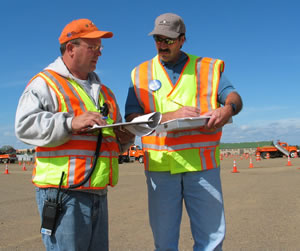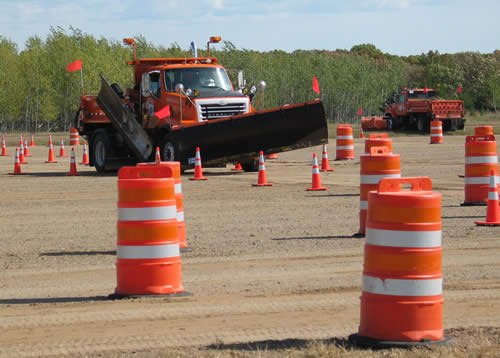
Ron Heim, a senior transportation generalist at Faribault and training team dispatcher (left), reviews trainees' performance with Brian Barott, a Metro District training coordinator. Photo by Jenny Seelen
|
By Craig Wilkins
Tanks and other heavy military vehicles gave way on some Camp Ripley roads when 86 new and not-so-new Mn/DOT employees engaged in two weeks of snowplow operator training in mid-September.
Trainees also included four employees from Scott County and two from West Des Moines, Iowa.
The program, known as SPOT for snowplow operator training, was started in 2003 to meet Mn/DOT’s need to train transportation workers and other employees whose duties may include snowplowing.
The training effort also helps ensure consistent operating and safety practices throughout the department.
Staff from the Office of Maintenance and each district conducted the training and evaluations. New drivers have to pass three tests to graduate: a snowplow road test, a vehicle inspection test and a written motor carrier safety exam.
During this year’s training, students did nearly everything except plow actual snow as they gained experience and confidence guiding the huge plows on varying terrain and road conditions on the Minnesota National Guard facility near Little Falls.
Rick Shomion, training coordinator, Maintenance, said the trainees did classroom work, then moved outside to practice dropping sand and maneuvering a truck mounted with front and wing plows through a demanding obstacle course.
The classroom work included vehicle maintenance, maintaining proper speed and distance from other vehicles while plowing and conducting pre- and post-operational reports.
The trainees were formed into 12- to 15-member teams.

A trainee negotiates a snowplow through an obstacle course during SPOT training at Camp Ripley. Photo by Jenny Seelen
|
Don Holt, a maintenance supervisor at Bemidji, served as a training team leader.
“This year’s class was excellent,” he said. “I think we do a better job each year.”
Holt said he expected to learn more than he taught.
“As time goes by, we learn from our mistakes and evolve. Every year I learn something I didn’t know about how our snowplows function,” he said.
While instructing his team on pre-operations inspection, for example, Holt learned about a problem with a control valve that’s part of the plow’s pre-wetting systems from a student.
He also learned some new ways to do things from his peers.
Holt served with the Metro District until this year. At Metro, he said, mounting strobe lights on wing plows didn’t work because of reliability issues.
But at this year’s SPOT session, he learned that District 1 has had success with the plow-mounted strobes, encouraging him to try them at Bemidji.
He also learned that some districts are slotting their sanding spinners to better control chemical distribution on the roadways.
“Our snowplows are becoming more and more sophisticated as we adopt new technologies,” Holt said. “The SPOT program is one way we can all learn together as we develop better ways to serve the state’s motorists.”
|



